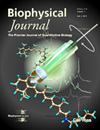评价酿酒酵母蛋白酶体衰变中的单细胞变异性。
IF 3.1
3区 生物学
Q2 BIOPHYSICS
引用次数: 0
摘要
基因表达是一个随机过程,即使在相同环境中生长的等基因细胞群体中,也会导致mRNA和蛋白质丰度的变化。这种变异通常被称为基因表达噪声,通常归因于转录和翻译过程,而忽略了细胞间蛋白质衰变变异性的贡献。在这里,我们使用延时显微镜估计了酿酒酵母中两种降解gfp的单细胞蛋白质衰变率。我们发现在退化gfp的衰减率中存在着大量的细胞间变异性。我们评估了解释蛋白酶体衰变变异性的细胞特征,发现蛋白酶体的20s催化β亚基的数量在一定程度上解释了观察到的降解GFP半衰期的变异性。我们提出了另一种假设,可以解释在两阶gfp衰减中观察到的变异性。总的来说,我们的研究强调了在单细胞分辨率下研究衰变过程动力学的重要性,并且衰变速率在单细胞水平上变化,并且衰变过程是随机的。在建立随机基因表达模型时,必须考虑复杂的衰减动力学模型来估计基因表达噪声。本文章由计算机程序翻译,如有差异,请以英文原文为准。
Evaluating single-cell variability in proteasomal decay within Saccharomyces cerevisiae.
Gene expression is a stochastic process that leads to variability in mRNA and protein abundances even within an isogenic population of cells grown in the same environment. This variation, often called gene-expression noise, has typically been attributed to transcriptional and translational processes while ignoring the contributions of protein decay variability across cells. Here we estimate the single-cell protein decay rates of two degron GFPs in Saccharomyces cerevisiae using time-lapse microscopy. We find substantial cell-to-cell variability in the decay rates of the degron GFPs. We evaluate cellular features that explain the variability in the proteasomal decay and find that the amount of 20s catalytic beta subunit of the proteasome marginally explains the observed variability in the degron GFP half-lives. We propose alternate hypotheses that might explain the observed variability in the decay of the two degron GFPs. Overall, our study highlights the importance of studying the kinetics of the decay process at single-cell resolution and that decay rates vary at the single-cell level, and that the decay process is stochastic. A complex model of decay dynamics must be included when modeling stochastic gene expression to estimate gene expression noise.
求助全文
通过发布文献求助,成功后即可免费获取论文全文。
去求助
来源期刊

Biophysical journal
生物-生物物理
CiteScore
6.10
自引率
5.90%
发文量
3090
审稿时长
2 months
期刊介绍:
BJ publishes original articles, letters, and perspectives on important problems in modern biophysics. The papers should be written so as to be of interest to a broad community of biophysicists. BJ welcomes experimental studies that employ quantitative physical approaches for the study of biological systems, including or spanning scales from molecule to whole organism. Experimental studies of a purely descriptive or phenomenological nature, with no theoretical or mechanistic underpinning, are not appropriate for publication in BJ. Theoretical studies should offer new insights into the understanding ofexperimental results or suggest new experimentally testable hypotheses. Articles reporting significant methodological or technological advances, which have potential to open new areas of biophysical investigation, are also suitable for publication in BJ. Papers describing improvements in accuracy or speed of existing methods or extra detail within methods described previously are not suitable for BJ.
 求助内容:
求助内容: 应助结果提醒方式:
应助结果提醒方式:


